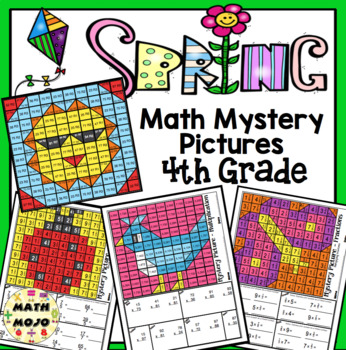4th Grade Spring Math: 4th Grade Math Mystery Pictures
- PDF
What educators are saying
Also included in
- 4th Grade Math Mystery Pictures: Whole Year Bundle - Keep your students engaged and motivated for the whole year with this set of 4th grade math mystery pictures. There are pictures for each season (fall, winter, spring, and summer). The set includes 32 pictures in all!These math mystery pictures arPrice $9.60Original Price $12.00Save $2.40
Description
4th Grade Math Spring Mystery Pictures - Make math class something to look forward to with this set of 4th grade spring math mystery pictures. These math mystery pictures are engaging and can be completed independently. They are self-checking, cover key 4th grade math skills, and the pictures and problems are all on 1 page. They are great activities for fun spring math activities, 4th grade math skill review, homework, fast finishers, centers, or extra practice.
This set includes 8 spring themed math mystery pictures that review the following 4th grade math topics:
* Double Digit Multiplication
* Long Division: 3 Digit Numbers Divided By 1 Digit Numbers
* Area
* Symmetry
* Improper Fractions
* Multiplying Fractions
* Fractions and Decimals
* Comparing Decimals
★ For more math mystery pictures:
★ For more Valentines Day fun check out:
✔ Valentine's Day Math - 4th Grade
✔ Valentine Geometry Game Show (Common Core Aligned - 4th Grade)
★ You might also like:
✔ Math Games and Centers: 4th Grade Print and Play, No Prep
✔ Math Exit Slips 4th Grade Common Core All Standards Mega Bundle
✔ 4th Grade Common Core Math Assessments - All Standards Bundle
✔ 4th Grade Math Skills Scoot Mega Bundle
✔ Math Games and Centers: 4th Grade Print and Play, No Prep
✔ 4th Grade Math Task Cards Mega Bundle All Domains and Standards
✔ Math Test Prep (4th Grade Common Core) All Standards Mega Bundle
✔ Math Test Prep (Rock the Test) 4th Grade Common Core All Standards Mega Bundle
✔ Math Test Prep (Boot Camp Theme) 4th Grade Common Core All Standards Mega Bundle
✔ Math Test Prep (Super Hero Theme) 4th Grade Common Core All Standards Mega Bundle
✔ 4th Grade Common Core Test Prep - All Standards Mega Bundle






